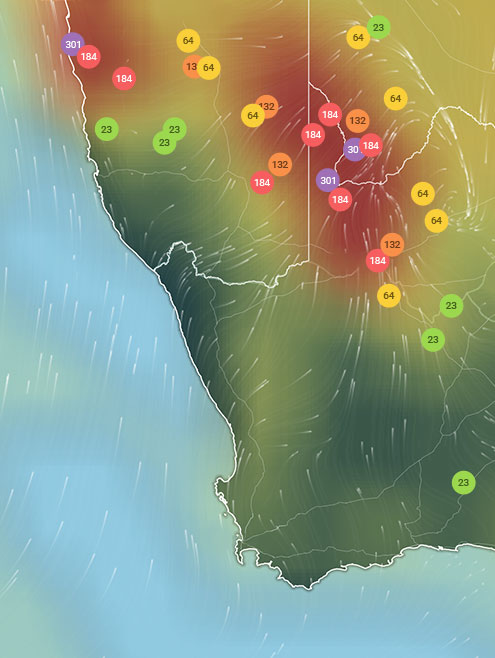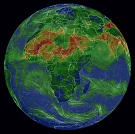Be the first to measure and contribute air quality data to your community
2.8K people follow this city






AIR QUALITY DATA SOURCE
Find out more about contributors and data sources| Weather | Clear sky |
| Temperature | 84.2°F |
| Humidity | 90% |
| Wind | 9.7 mp/h |
| Pressure | 29.6 Hg |
| # | city | US AQI |
|---|---|---|
| 1 | Dhaka, Dhaka | 125 |
(local time)
SEE WORLD AQI RANKING
US AQI
92*
live AQI index
Moderate
| Air pollution level | Air quality index | Main pollutant |
|---|---|---|
| Moderate | 92* US AQI | PM2.5 |
| Pollutants | Concentration | |
|---|---|---|
| PM2.5 | 31.5*µg/m³ | |
PM2.5
x6.3
PM2.5 concentration in Manikganj is currently 6.3 times the WHO annual air quality guideline value
| Sensitive groups should reduce outdoor exercise | |
| Close your windows to avoid dirty outdoor air GET A MONITOR | |
| Sensitive groups should wear a mask outdoors GET A MASK | |
| Sensitive groups should run an air purifier GET AN AIR PURIFIER |
| Day | Pollution level | Weather | Temperature | Wind |
|---|---|---|---|---|
| Today | Moderate 92 AQI US | 105.8° 78.8° | ||
| Sunday, Apr 28 | Moderate 94 AQI US | 109.4° 80.6° | ||
| Monday, Apr 29 | Moderate 98 AQI US | 111.2° 80.6° | ||
| Tuesday, Apr 30 | Moderate 95 AQI US | 111.2° 78.8° | ||
| Wednesday, May 1 | Moderate 90 AQI US | 113° 80.6° | ||
| Thursday, May 2 | Moderate 85 AQI US | 111.2° 82.4° | ||
| Friday, May 3 | Moderate 88 AQI US | 107.6° 82.4° | ||
| Saturday, May 4 | Moderate 96 AQI US | 109.4° 80.6° |
Interested in hourly forecast? Get the app
Manikganj is a city and district headquarter of Manikganj District in the division of Tangail, Bangladesh. With a population of 200,000, it is not a huge city.
In early 2021, Manikganj was enjoying a period of “Good” quality air with a US AQI reading of just 25 which firmly places it in the Good category, as defined by the WHO (World Health Organisation). The concentration level of PM2.5 was just 6 µg/m³.
Out of the six main cities in Bangladesh, Manikganj ranked as number 6. The worst offender was Sreepur in Dhaka with a US AQI figure of 138. Even the closest to Manikganj was Comilla in Chittagong with a number of 61.
The winter months of December, January and February seem to be the worst for air quality in Manikganj. With recorded figures between 150.5 and 250.4 µg/m³, it falls into the “Very unhealthy” WHO classification. We then need to look at the months of spring and autumn (March, April – October, November) when the air quality was marginally better with figures between 55.5 and 150.4 µg/m³ which classed it as “Unhealthy”. May seems to be a transitional month when the air is “Unhealthy for sensitive groups” with figures between 35.5 and 55.4 µg/m³. June through to the end of September sees the best quality air for Manikganj when the quality is “Moderate” with readings between 12.1 and 35.4 µg/m³.
There were no records kept of the level of air quality before 2020 when the mean figure for the year was 80.2µg/m³.
Out of the 6 cities in Bangladesh that are part of the AQI monitoring system, Manikganj comes in as the most polluted city with this 80.2 µg/m³ reading. Closely followed by the capital city, Dhaka with 77.1 µg/m³. Tying for the third position are Azimpur and Sreepur with equal readings of 55.7 µg/m³. The cleanest air is found in Narayanganj with a comparatively low figure of 21.8 µg/m³ which would classify it as being “Moderate” quality.
In 2019, there were calls to close down illegally operating brick kilns in five districts around Dhaka in an attempt to forcibly clear the air. Dhaka is constantly noted as being the most polluted city in the world and the local government had decided to do something about improving air quality.
"South Asia remains the most polluted region of the world with Bangladesh, India and Pakistan sharing 42 of the 50 most polluted cities worldwide. This was revealed through the latest data from IQAir's global air quality website in its World Air Quality Report 2020. The report stated that the average annual concentration level of PM2.5 was 77.1 µg/m³ which is 7 times higher than the recommended level as suggested by the World Health Organisation (WHO).
It also went on to say that between 13 and 22 per cent of all deaths in this region were directly linked to the poor quality air.
In April 2021, following on from the results in the IQAir report, an emergency meeting was held and it was decreed that all garbage burning within the city limits should stop immediately, together with the closure of the aforementioned kilns. It was also strongly suggested that water is sprayed on the road surfaces to stop the dust rising up into the air when passing traffic disturbs it.
The smog from brick kilns, smoke from un-roadworthy vehicles and dust generated from public and private constructions sites, including those of the mega projects taken by the government, are the main causes of air pollution. Brick kilns were identified as the single largest source of air pollution in Dhaka city, with 50 per cent of the total pollution attributed to those.
In 2013 the number of brick kilns throughout the country was almost 5,000 but the number rose to over 8,000 just 5 years later. This manufacturing sector uses over 3.5 million tons of coal and almost 2 million tons of firewood which, when combined, release over 10 million tons of greenhouse gases, annually. An alternative is slowly becoming available with the development of “green bricks”. These are produced from pressurised by-products of the coal-fired power plants which save on energy during their production and also is less pollutive.
Compounding the situation is the rising number of registered vehicles. The number of these has increased over the years, contributing to air pollution. According to data from the Bangladesh Road and Transport Authority, the number of motor vehicles in Dhaka almost doubled in the last nine years.
According to research findings, the three main sources are brick kilns, fumes of vehicles and dust from construction sites. The dust particles are contributing to the city's worsening air pollution due to construction work which should be shielded and sprayed, but this does not always happen.
Medical experts suggest that dust concentration in the air usually increases five times during the dry season and dust particles from construction sites worsen the situation. Inhaling dust can severely damage the respiratory system and cause various lung diseases as well as viral and bacterial infections.
Air pollution causes respiratory diseases such as COPD. Due to air pollution, bronchial asthma takes extreme form. Apart from this, it causes fatigue, headache and anxiety, irritation to the eyes, nose, throat, damage to the nervous system, bad effect on the cardiovascular system.
During the winter season, the air humidity decreases and straw is burnt in the surrounding fields. This causes air pollution to rise to its highest level. The effects of this can include respiratory diseases such as asthma and lung problems, cardiovascular diseases, bad results in pregnancy such as premature delivery and even death.
Do not do strenuous exercise in the open air, such as cycling or jogging or running. Especially in the morning and evening when the level of air pollution is very high due to the increased presence of ozone. Ozone needs sunlight to form, so is often found at higher concentrations during the early afternoon when the sunlight is at its strongest. Instead, you can exercise indoors at the gym, or even walk through the local shopping mall. Restrict outdoor activities for children too.
No locations are available.